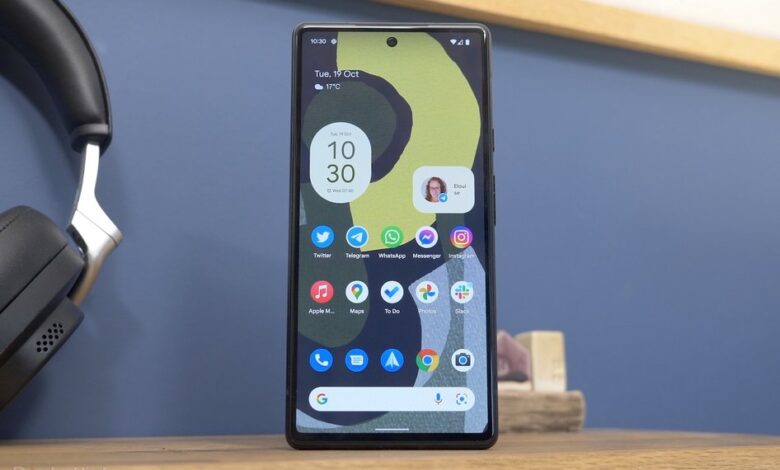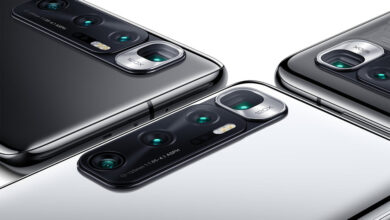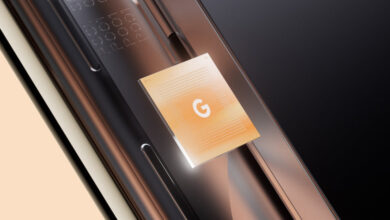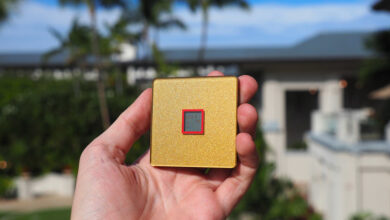Google Pixel 6 initial review: Starting fresh

[ad_1]
(Pocket-lint) – The Pixel 6 is undoubtedly the worst kept tech secret in recent years. Predominantly because Google hasn’t really wanted to keep it a secret. Instead of keeping hush on the leaks when they first surfaced, Google confirmed them and has been pushing big marketing bucks behind the phone in the run up to the official announcement.
In the UK at least, Google’s messaging has very much been that this is the next cool thing, a phone for people with their finger on the pulse, those who want to be different to everyone else. It’s a trendy phone. With its unique design and fresh software experience, it’ll certainly get people interested, that’s for sure.
Like no other
- 158.6 x 74.8 x 8.9 mm
- 207 grams
- Stormy Black, Sorta Seafoam and Kinda Coral colours
- IP68 water and dust resistant
- Corning Gorilla Glass Victus
It’s safe to say that whether you look at it from the front or the back, the Pixel 6 doesn’t quite look like any other Android smartphone on the planet. Or – at least – is as different as a glass rectangle can be.
Part of that distinctiveness is down to the design of frame and bezel. It’s very rectangular and right-angled, but still has skinny bezels. Rather than go with a rounded appearance around the corners with an internal curved corner in the bezel, Google opted to make them close to square. In a way it almost has a Nokia Lumia-esque vibe to it.
Despite those right angled corners, the frame is still rounded to make it feel comfortable in the hand. A feel that’s further enhanced by the slight curves in the glass on the back of the phone. It doesn’t feel sharp or flat like the iPhone 13. Being much larger and less round than the Pixel 5, it’s not quite as ergonomic as its predecessor though.
It’s on the back of the phone you’ll find the most striking difference between this and other phones. Just one quick glance and anyone will see it’s not quite the same as other devices. There’s no rectangular, square or pill-shaped camera protrusion in the corner. Instead, Google’s spread the camera unit across the entire width of the phone.
The protrusion is capped at the top and bottom by an aluminium frame that joins with the main chassis of the phone, and solves a minor issue with the usual corner-place method. It means when you lie the phone on its back, it won’t wobble.
Apart from that, it’s all a pretty standard affair. The volume rocker and wake/sleep key live on the right edge, the SIM tray is in the left and a type-c port on the bottom. There’s no physical figerprint sensor this year, instead Google went with an optical in-display sensor, and there’s a centrally placed front facing camera punching through the top of the display.
The regular Pixel 6 comes in three colours. Our review unit is the Stormy Black, which features a tri-tone finish with dark grey forming the predominant colour on the back, with a black camera panel and a lighter grey panel above that. Other colourways include the more eye-catching pink Kinda Coral and Sorta Seafoam green. As Incubus once said in one of its best songs: it’s so much easier when seafoam green is in fashion.
Display and software
- 6.4-inch OLED display
- 1080 x 2400 resolution (411ppi)
- 90Hz adaptive refresh rate
- 24-bit colours and HDR10 support
Reading down the display spec list reads pretty much like any other standard Android flagship phone. That’s to say it’s a full HD+ resolution 20:9 ratio display built with an OLED panel and capable of reaching up to 90Hz refresh rates. It’s not quite up there with the top 120Hz panels, but at the price point it’s sitting at, that’s no surprise. Still, with up to 90 frames per second the screen should be capable of very fluid and responsive motion.

It’s equally adept at colour and contrast too if Google’s specs are anything to go by. With 24-bit colour capabilitiy it’s capable of up to 16 million colours, supporting wide gamuts and with enough contrast and brightness to make HDR10 content look its best. We’ll need to test it further to see exactly how good it is.
As always with the Pixel line of phones, it’s not necessarily the technical capabilities of the screen that’s the most important thing. Rather, it’s the software and interface it acts as the window to. For 2021, that particular software is Android 12 and it’s safe to say this is the biggest visual change we’ve seen in an Android update, well, ever.
Much of the main interface and layers have been compelely redesigned. From the drop-down notifications and quick setting shade to the lock screen and widgets. It’s all new. What’s more, there are tonnes of new animations for things like unlocking the phone, or plugging it in to charge, all of which are well suited to the 90Hz refresh screen.

Two things stand out, however. First: Automatic theming. When you set a new wallpaper in Android 12, the system accent colour changes to match the predominant colours in that wallpaper. Second: Widgets. There’s an new style of widget for Google functions like the clock, weather, conversations and Keep notes.
It comes with all the other benefits too, like the additional security measures. Those include the Privacy Dashboard that gives easy access to your permissions, so you can quickly see which apps have access to your location, mic, camera and other data. There are quick toggles to switch off your microphone and camera in the quick settings too.
Tensor power
- Google Tensor processor – Titan M2 security co-processor
- 128GB or 256GB storage
- 4614mAh battery – 30W PD charging support
- Qi wireless charging
The design of the Pixel 6 maybe the first big talking point of the latest Google phone, but there is one other that’s as – if not more – important: the processor. Google has gone down a similar route to Apple and now uses its own home-baked processor called Tensor.
Google’s is claim is that you’ll get an 80 per cent increase in performance over the Pixel 5. That phone, however, was powered by the Snapdragon 765G processor, which wasn’t the most powerful processor on the market at the time. It didn’t reach the speed and performance of any 800-series chipset. We’ll need more time testing the phone to see how it compares to genuine flagship power phones.

Likewise, the battery inside is similar in capacity to what you’ll find in many Android phones. At 4614mAh typical capacity, there should be easily enough to ensure you can get through the work day on a single charge. Again, more testing is required to see what it’s like day-to-day. Its 30W charging capabilities aren’t lightning quick either, but should be enough to ensure you’re not wasting hours waiting for it to refill when empty.
Pixel perfect
- Dual camera system
- 50MP f/1.85 primary camera with ‘Super Res Zoom’ up to 7x
- OIS, EIS and laser-detect AF
- 12MP f/2.2 ultrawide 114-degree camera
- 8MP f/2.0 selfie camera
One major difference between this and the Pro model of the new pixel line up is the camera capabilities. The regular Pixel 6 features a dual camera system made up of a primary wide lens and an ultrawide lens.

Its main sensor is a 50MP 1/1.31-inch sensor that packs enough pixels that Google has been able to enable a feature called ‘Super Res Zoom’, essentially allowing you to use a digital zoom up to 7x without losing much in the way of detail. That’s achieved, essentially, by cropping into the sensor and using all the pixels available.
As is usually the case for Google’s phone cameras, there’s lots of computational work being done behind the scenes too for processing colours, light and detail. It has also enabled a host of cool camera features that let you do things like edit out people photobombing or unwanted people/objects in the background of your photos. You can also automatically reduce blur in selfies, or even make use of a couple of new exposure tricks.
Motion mode will allow you to shoot either a long exposure shot to produce effects like light trails on moving cars, or shoot an action pan where you keep the subject in focus while it moves by, blurring the background to make the subject looking like its moving quickly. There’s also the recent addition of Real Tone, which seeks to more accurately expose and process all skin tones.
There are two big talking points with the Pixel 6: The unique design and the Google-made processor. This focus on creating a phone that’s visually distinct from everything else on the market while also investing in its own home-grown silicon suggests Google is taking this smartphone thing very seriously.
What’s more, Android 12’s interface is so different to previous software that there’s barely a feature on this phone that’s identical to the competition. Whether or not that – plus the heavy marketing investment – will be enough to get more people buying Pixels is yet to be seen.
Writing by Cam Bunton. Originally published on .
[ad_2]
Source link





